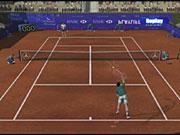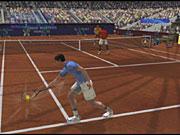What made Sega's Virtua Tennis such a landmark game, and so widely enjoyable, wasn't that it tried to faithfully translate the sport of tennis into video game form, but that it was more concerned with creating an enjoyable game that captured the overall look and feel of tennis. Though Microids' Tennis Masters Series 2003 resembles the Virtua Tennis games in many parts of its execution, its more realistic approach creates a game that is more deliberately paced and not quite as accessible or entertaining. The lack of gameplay options also hurts Tennis Masters Series 2003, despite the fact that, fundamentally, it's a fairly sound game.

You'll basically see all the gameplay options Tennis Masters Series 2003 has to offer when you first get to the main menu screen. You can play a singles or doubles exhibition match, either by yourself or with up to three other players. The tournament mode pits you against AI opponents in a series of nine different ladder-style competitions leading up to the prestigious Tennis Masters Cup. And that's it. No training modes, no custom career modes, no real extras at all. Not to detract from the tournament and exhibition modes, because there's really nothing wrong with either of them, but the game just could've used more variety.
As fans of modern video game tennis might expect, the actual action in Tennis Masters Series 2003 is akin to that of the Virtua Tennis games, though with much more restraint. You'll use a rising power meter to determine the strength of your serve, and you can affect the direction of the ball by moving the analog stick right before you make contact with it, while serving and while in the middle of a match. The four main face buttons on the controller are mapped to the different types of shots you can use during a match, and each one plays a vital role. The topspin and power top shots are both speedy, straightforward shots that are good for finishing a point off. A slice shot is a slower shot, giving you time to get to a better position if you find yourself on the fringes of the court, and it has a low bounce, making it hard to return with much power. Finally, a lob shot is absolutely critical in warding off an opponent who's trying to ride the net. The general basics of these mechanics are fine, but where the game gets tripped up is in the specifics. Though you have to press the swing button a beat or two before you actually make contact with the ball to get the full potential out of the shot, the system in Tennis Masters Series 2003 is somewhat inconsistent, and you'll often find yourself swinging at thin air when you intended to charge up for an incoming shot.
In an attempt to add a bit of real-life depth to the gameplay, the game features a fatigue meter that slowly drains over the course of the match. This generally has little effect in a one-off exhibition game, but during the long, grueling tournaments, it makes each point more and more sluggish. This effect might add some realism to the proceedings, but it certainly doesn't add any fun. There are plenty of other examples of the game trying to make things feel more "realistic," such as making jumping smash shots riskier by creating a significant recovery delay, or making a dive shot an incredibly rare feat, but honestly, they just make the game kind of dull.
The AI in Tennis Masters Series 2003 puts up a pretty fair fight, but it can become pretty predictable, mostly because the play style doesn't vary enough between different opponents. The AI also has a tendency to ride the net, though instead of going for aggressive high-powered shots like you might expect, it simply nudges its volleys over the net. This behavior is annoying, and it's not terribly true to the sport.
Though Tennis Masters Series 2003 is understated even from a graphical standpoint, the visual components are all technically sound, and they come together to make a presentation that's more functional than flashy. The character models are well rendered, and they have a convincing set of animations for a variety of different situations. The motion blur on the rackets and the ball, as well as the modest starburst you'll get when making contact with the ball, add extra resonance to the action. The characters also cast very crisp, clean-looking shadows, and certain arenas will cast shadows over part of the court, producing a nice layered lighting effect. Though the grandstands are populated by roughly animated cardboard people, you only catch a glimpse of them in the flyby before a match, and much more care was taken with the rest of the court. You'll find that the players will leave footprints on certain court surfaces, which is a nice little touch, but it has the unfortunate side effect of causing a slight but noticeable frame rate issue.

The game's sound is also pretty underplayed. The only time you'll be treated to any music is when you're on a menu screen, though admittedly, the music there is of a deliciously cheesy guitar rock variety. While in a match, the sound is stripped-down but functional. The sound of the ball making contact with the racket is crisp, and the crowd noise is rather well done, swelling when a point is scored or a miraculous save is made. The announcers stick strictly to the business of calling scores, though you'll get a different announcer depending on where you're playing. This means sometimes you'll get your scores read to you in a different language, adding a little international flavor to the proceedings. More ambient noises, and the occasional grunt or yelp from the players, would've fleshed out the soundscape a bit, but what's present is passable.
The Tennis Masters series has been going on the PC for two years already, with each installment making a tangible improvement on its predecessor. Though this edition may be the most fully realized so far, it still has some noticeable shortcomings that keep it from delivering a truly satisfying game of tennis. If Microids can address the inconsistencies in the gameplay, and add more modes of play, thus creating a more full-featured product, this might be a series worth paying attention to.